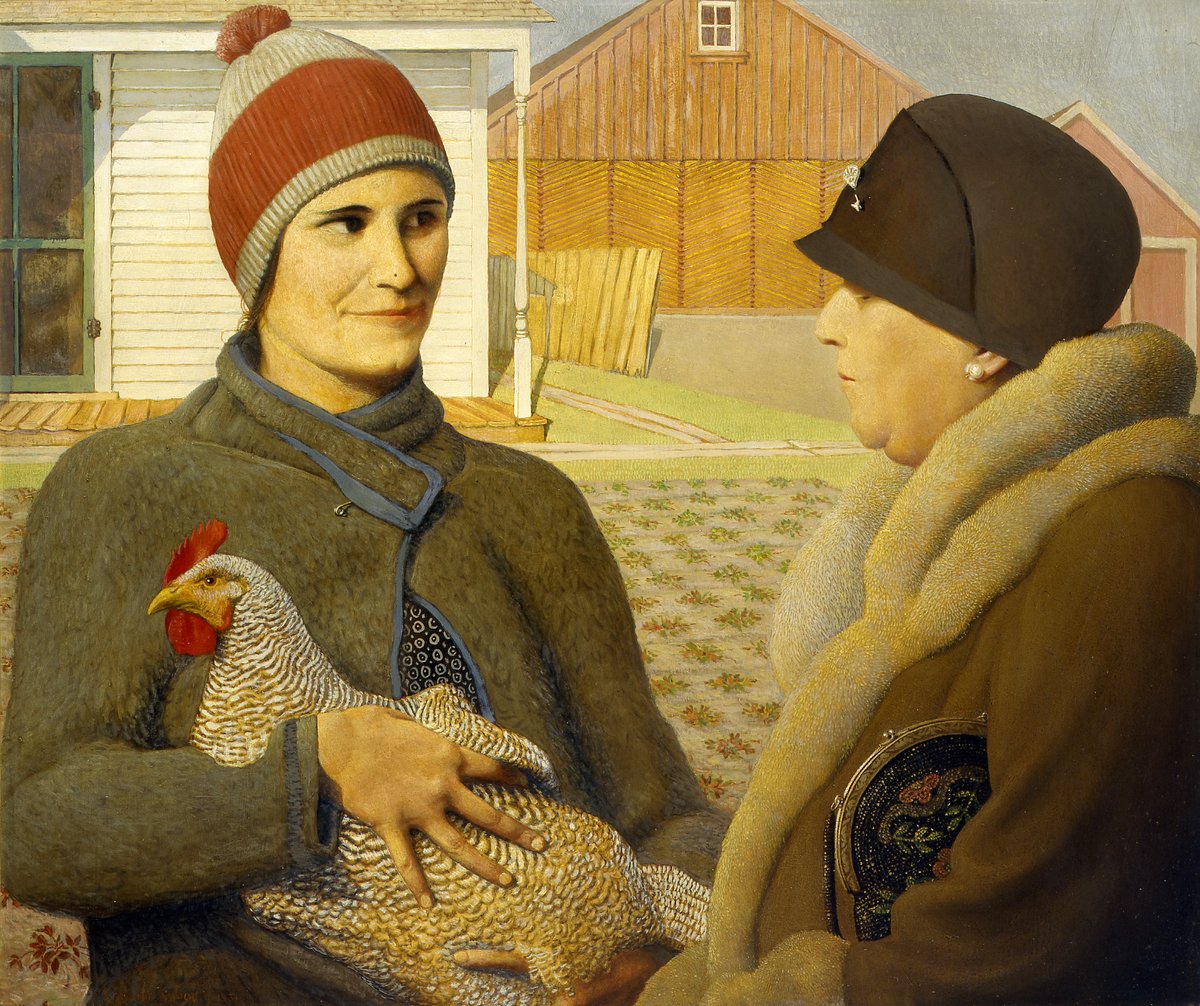
“Grant Wood: American Gothic and Other Fables“
Whitney Museum of American Art, New York
Through June 10, 2018
What the Museum Says: “Wood sought pictorially to fashion a world of harmony and prosperity that would answer America’s need for reassurance at a time of economic and social upheaval occasioned by the Depression. Yet underneath its bucolic exterior, his art reflects the anxiety of being an artist and a deeply repressed homosexual in the Midwest in the 1930s. By depicting his subconscious anxieties through populist images of rural America, Wood crafted images that speak both to American identity and to the estrangement and isolation of modern life.”
Why It’s Worth a Look: The iconic painting American Gothic, a double-portrait of a dour-faced Midwestern couple in front of a white farmhouse, is the centerpiece of this sprawling retrospective, the first major examination of Grant Wood’s work in over 20 years. But Wood was much more than American Gothic. The Whitney has assembled more than 100 works that reveal the painter’s hugely diverse oeuvre, which includes decorative art objects, book illustrations, and public commissions.
It makes sense that Wood, who became known as a pioneer of American Regionalism, would use his rural upbringing as source material. After a stint traveling abroad, he gave up on trying to emulate what he called “Europy-looking” subjects and opted instead to depict a placid, wholesome view of American life. What is more surprising is that most of these works are cast in the shadow of Wood’s long-repressed sexuality, prickly personality, and interest in the macabre—making them far from a simple endorsement of the heartland.
What It Looks Like:
Grant Wood’s Boy Milking Cow from “Fruits of Iowa” series, (1932). Collection of Coe College, Cedar Rapids, Iowa. © Figge Art Museum, successors to the Estate of Nan Wood Graham/Licensed by VAGA, New York, NY. Photograph by Mark Tade, 2005.
Grant Wood’s BFarmer With Pigs and Corn (1932). Coe College, Permanent Art Collection, Cedar Rapids, Iowa. © Figge Art Museum, successors to the Estate of Nan Wood Graham/Licensed by VAGA, New York, NY. Photograph by Mark Tade, 2005.
Grant Wood’s Spilt Milk (1935). © Figge Art Museum, successors to the Estate of Nan Wood Graham/Licensed by VAGA, New York, NY. Image courtesy Sotheby’s
Grant Wood’s Arnold Comes of Age (Portrait of Arnold Pyle) (1930). © Figge Art Museum, successors to the Estate of Nan Wood Graham/Licensed by VAGA, New York, NY. Photograph © Sheldon Museum of Art.
Grant Wood’s Sultry Night (1939). © Figge Art Museum, successors to the Estate of Nan Wood Graham/Licensed by VAGA, New York, NY. Image © The Metropolitan Museum of Art, New York; courtesy Art Resource, NY.
Grant Wood’s Saturday Night Bath (1937). Courtesy of the Museum of Fine Arts, Houston.
Grant Wood’s Parson Weems’ Fable (1939). Amon Carter Museum of American Art, Fort Worth, Texas. © Figge Art Museum, successors to the Estate of Nan Wood Graham/Licensed by VAGA, New York, NY. Image © The Metropolitan Museum of Art, New York; courtesy Art Resource, NY.
Grant Wood’s Spring in Town (1941). Courtesy of the Swope Art Museum, Terre Haute, Indiana.
Grant Wood’s Spring Turning (1936). Courtesy of the Reynolda House Museum of American Art, Winston-Salem, North Carolina.
Grant Wood’s The Midnight Ride of Paul Revere (1931). Courtesy of the Metropolitan Museum of Art, NY.© Figge Art Museum, successors to the Estate of Nan Wood Graham/Licensed by VAGA, New York, NY. Image © The Metropolitan Museum of Art, New York; courtesy Art Resource, NY.
Grant Wood’s Death on the Ridge Road (1935). © Figge Art Museum, successors to the Estate of Nan Wood Graham/Licensed by VAGA, New York, NY.
Grant Wood’s Stone City (1930). Joslyn Art Museum, Omaha. © Figge Art Museum, successors to the Estate of Nan Wood Graham/Licensed by VAGA, New York, NY.
Grant Wood’s Self Portrait (1932/41). © Figge Art Museum, successors to the Estate of Nan Wood Graham/Licensed by VAGA, New York, NY.
Grant Wood’s American Gothic (1930). Courtesy of the Art Institute of Chicago.
Grant Wood’s Daughters of Revolution (1932). © Figge Art Museum, successors to the Estate of Nan Wood Graham/Licensed by VAGA, New York, NY.
Grant Wood’s Woman with Plants (1929). © Figge Art Museum, successors to the Estate of Nan Wood Graham/Licensed by VAGA, New York, NY.